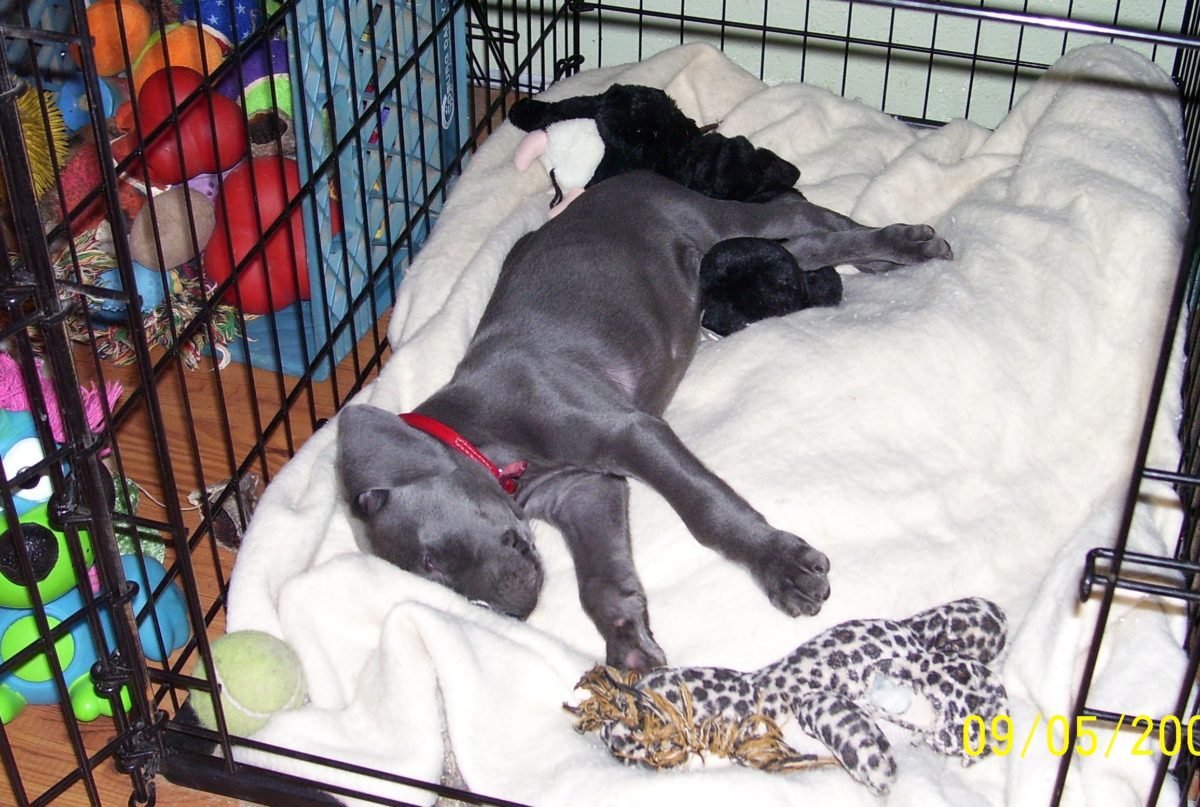Crate training your dog is a new concept for many, but is a very effective training tool for adult dogs and puppies.
If you have a new dog or puppy, a crate is a fantastic way of teaching it the boundaries of the house and keeping it safe. When you’re traveling in the car, visiting the vet or any other time you may need to confine your dog (eg. after surgery or if it has been injured), it’s much easier and safer if your dog has been trained to enjoy being in a crate.
How big and what type should I get?
A crate should be big enough for your dog to stand up, turn around and lie down. Crates can be plastic (used on airlines), wire (collapsible, metal pens) or collapsible fabric crates. It is not recommended to leave your dog for long periods in a fabric crate unless you are certain that your dog will be happy and calm inside it and will not scratch its way out.
What will my dog think?
A crate is intended to be a ‘safe haven’ or ‘security blanket’ for the dog. By nature, dogs like small, enclosed spaces, especially when they are feeling a little bit unsure. By providing your dog with an area where it can ‘escape’ and know it won’t be bothered, it can readily seek out this area when it needs a bit of a break or time-out.
Training using the crate
The duration of crate training varies from dog to dog. It will depend on the dog’s age, temperament and past experiences. It is very important to remember that your crate should be associated only with something pleasant and training should always move at your dog’s pace. Always vary the length of time that your dog will spend in its crate, especially during training. This will prevent your dog from ‘expecting’ to be let out at a particular time and reduce any issues such as whining or scratching at the crate door.
It may take a little time and effort to train your dog to use the crate, but it can prove useful in a variety of situations.
Introducing the crate
Place the crate in a central part of the household (living room, TV room, etc). Make the crate inviting and comfortable for your dog. Usually, dogs will go over and investigate. When your dog goes near the crate, reward it by throwing a food treat into the crate or near its entrance. Repeat this every time the dog goes near the crate. If the dog settles down inside the crate, reward this behaviour either with your voice or with food rewards. You want the dog to view the crate as a wonderful place to be, full of goodies and fun. You don’t want to shut the door of the crate just yet. Your dog needs to understand that it can come and go as it pleases, therefore reinforcing it as a good place to be.
Feeding your dog in the crate
Begin giving your dog its regular meals in the crate. Place the bowl inside the crate and encourage the dog to enter. If your dog readily enters the crate at dinner time, start asking it to go in and then place the food inside the crate. As the dog becomes more comfortable eating in the crate, you can introduce closing the door. Start by closing the door as your dog eats its meal. Make sure you open it before the dog finishes its meal. As you progress, gradually leave the door closed for a few minutes at a time. Soon you should have a dog that will happily stay in its crate after a meal. If the dog whines; ignore the behaviour and try to reward it or let it out as soon as it is quiet. Next time, make sure the dog is in the crate for a slightly longer period of time.
Increasing the time spent in the crate
Once your dog is happy in the crate for about 10 – 15 minutes after finishing its meal, you can start to confine it to the crate for longer periods. Get the dog into the crate using a command such as “crate” or “bed”. As the dog enters the crate, give it a treat, praise it and close the door. Quietly sit nearby for a few minutes and reward the dog for remaining calm and happy. You might even want to open the door and give the dog a rewarding treat-dispensing toy such as a Kong. Continue with your daily activities and return regularly to reward the dog, either verbally or with a food treat, for its calm behaviour inside the crate.
Start with short sessions and gradually increase the length of time that you leave the dog inside the crate. This may take several days or weeks, depending of the dog.
Crating your dog at night
Once your dog is happy spending time in its crate with you around, you can introduce it to crating at night. Make sure your dog has toys or treat-dispensing toys with it to initially settle it into the routine. Keep the crate in a familiar, central area so the dog feels comfortable and settled. With young puppies or older dogs you may need to take them out for toilet breaks during the night. By making the crate a ‘fun’ and enjoyable place to be, night time crating should be an easy transition.
Potential problems
Be careful that your puppy doesn’t spend too much time in its crate. While it is a fantastic tool for toilet training puppies and preventing destruction, a dog of any age should not spend all day in a crate while you are at work and again when you go to bed. This can affect your dog’s muscle development and condition. Young puppies shouldn’t spend more than 2-3 hours in the crate without a toilet break as they cannot last that long without relieving themselves.
Whining
If your dog begins whining in its crate, the best thing to do is ignore it. For a young puppy, whining may occur because it needs to relieve itself, so quietly take it out to the toilet on a lead, making sure not to play with it. Place it back into its crate once it has gone to the toilet. Remember that any sort of interaction, positive or negative, will be a ‘reward’ to the dog, so ignoring the whining is best. However, make sure that you reward the dog appropriately when it has settled and is quiet. Using a towel or sheet to cover the crate if the whining persists can also help settle the dog.
By following these steps, you can train your dog to not only love its crate, but also see it as a safe haven. Your dog’s crate can be a place to escape for a much-needed rest, a break from kids or other dogs, and even a portable home that will always be familiar no matter where you are.

